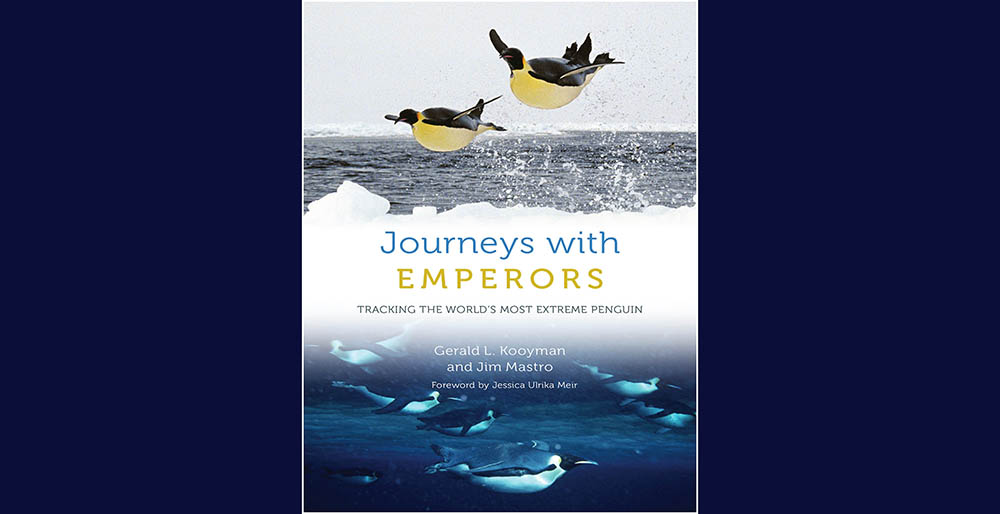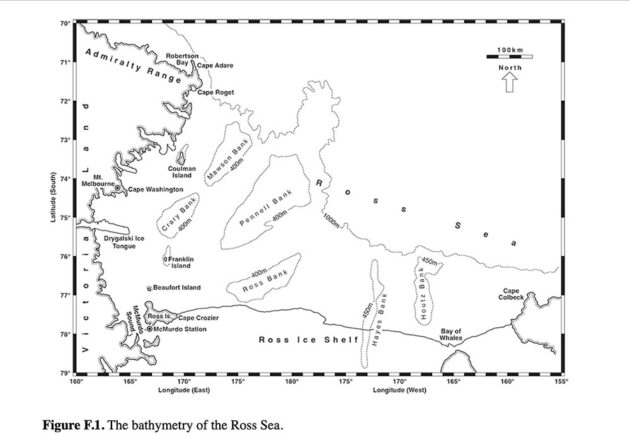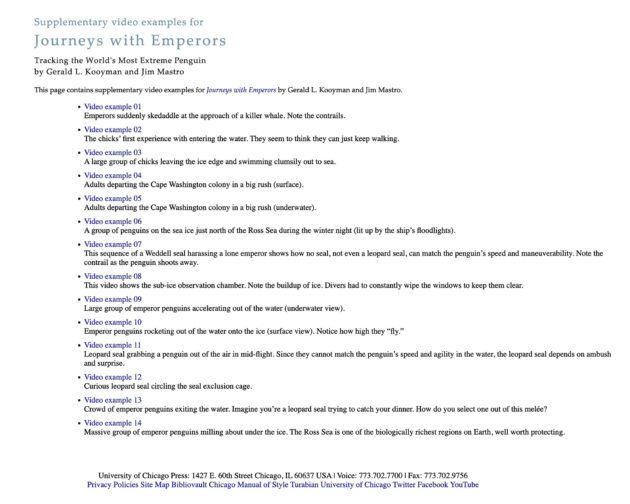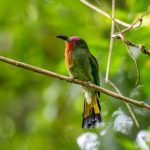
Journeys With Penguins: Tracking the World’s Most Extreme Penguin is a different type of penguin book. Author Gerald L. Kooyman (co-author with Jim Mastro) spent decades studying Emperor Penguins and can be considered the world’s foremost expert on the species. Journeys with Penguins is the story of how he came to research Emperor Penguins, how he devised methods to measure and observe these incredible creatures, about whom little was known because of their habitat in the coldest, darkest, most inaccessible regions of Antarctica, the experience of living on the ice of the Ross Sea, and what he and his team found out. It’s part memoir, part travelogue, part scientific narrative, part prologue to making an argument for Antarctic conservation. It’s all about the improbable intersection of human beings and Emperor Penguins, and if I can’t make it to an Emperor Penguin colony (highly unlikely), reading this book has been the next best thing.
Empire Penguins (Aptenodytes forsteri) are the largest living penguin species, almost four feet tall (taller when they stretch), and the least likely to be seen on birding or nature trips. They breed in colonies scattered around the Antarctic continent (the number ranges from 60 to 70, and as Kooyman points out, the colonies can drastically change in size from year to year) on the ice (and one of the things I learned from this book is how many different kinds of ice there is in the Antarctic) in the darkest months of winter. As we know from the French documentary La Marche de l’Empereur (March of the Penguins), the females skedaddle from the breeding colony once she produces an egg, leaving the egg to be incubated by the males, who fast for 120 days while keeping the egg in a flap of their feet. (I was surprised to find out that the Penguins studied by Kooyman at the Ross Sea have no need to do a march since they breed so close to the water.) Indeed, most of what we knew about Emperor Penguins before Kooyman’s research expeditions was about their breeding behavior and physiology. Kooyman wanted to know what they did the rest of the year.
He begins the book with his first in-person meeting with three Emperor Penguins, October 1961, at Cape Royds on the western side of Ross Island in -30-degree C temperatures: “Three amazing creatures blasted through the thin ice not far away and began sliding of their bellies toward me….Watching them, I thought if I froze to death before the day was over, I would cross the veil a happy man” (p.2). Kooyman was there to work at McMurdo Station (a large American research station that we hear about throughout the book) as technical assistant on a science mission involving fish. He leaves enchanted by two mammals, the Emperor Penguin and the Weddell Seal, the only mammals who totally live their whole lives, year-round, in the Antarctic. It’s the seal that he first studies, for his PhD and succeeding projects, and it isn’t till 20 years or so later, in the 1980’s, that he comes back to penguins, primarily the Emperor Penguins of the Ross Sea.
 “The bathymetry of the Ross Sea,” © 2023 by Gerald L. Kooyman and Jim Mastro
“The bathymetry of the Ross Sea,” © 2023 by Gerald L. Kooyman and Jim Mastro
The book is divided into two sections. Chapters 1 through 5 are the adventure chapters, tales of how Kooyman started his penguin research, details of his first forays in determining which penguin colony to study, then establishing a research camp on the ice in a place no researcher had gone before, Cape Washington. It wasn’t easy, he needed to figure out transportation; devise ways to study penguin behavior, live with teammates who are not always compatible (but who sometimes were, like when his son was part of the team); negotiate with administrators, pilots, and funding agencies (thankfully, there isn’t a lot of the latter in the book, though I’m sure Kooyman did enough that he became an expert). There was the discomfort of living in the bitter cold and dark, sometimes without proper clothing or equipment, especially in the early years; harrowing encounters with one of the area’s major predators, Leopard Seals; and a more insidious threat, melting ice. The narrative continues through 1989, the highlights being Kooyman’s early research missions at Cape Washington in 1986 and 1989,
The next six chapters focus on the science of the life of the Emperor Penguin, folding in Kooyman’s successive travels to Antarctica over the next three decades (his bio says he has been there 50 times): expeditions at Cape Washington, diving experiments at the “Penguin Ranch” at McMurdo Station, and Antarctic research trips on ships and icebreakers. He brings in findings from scientific endeavors conducted by other Antarctic researchers, making these chapters an engaging textbook on the current state of research on Empire Penguins. Four chapters are organized by the movements of the Empire Penguin: commuter journey (going out to feed and bringing food back to chicks), fledging journey, pre-molt journey, post-molt journey. Each section poses Kooyman’s research questions and then explains how he and his team went about trying to answer them, tracking journeys out to sea with (then) new technology of satellite transmitters, making sense of the data received, learning to accept the limits of what they could learn (still a lot of answered questions out there, such as the winter foraging behavior of females from the Ross Sea colonies).
The next chapter is the most scientifically oriented of the book, asking “How Do They Do It?,” how do Empire Penguins live their lives of extremes–extreme cold, extreme darkness, extreme dives. Because, as Kooyman proved with his self-devised time/depth recorders and dive circle research on the ice, Empire Penguins are incredible divers, recorded diving down to over 500 meters on a single breadth. It’s all about feathers, very dense feathers and very specific types of feathers, and a complex interplay of biological factors involving oxygen, aerobic and anaerobic metabolism, and lactate. I’m still struggling with understanding the latter, but that is not Kooyman and Mastro’s fault. They are excellent science writers, patiently explaining the physiological processes involved in deep diving in penguins, seals, and human. It is a complex topic and I was relieved to get on to what is one of the most entertaining sections of the book, the chapter on Emperor Penguins and their main predator, the Leopard Seal. Leopard Seals are commonly described as apex predators, they have giant jaws filled with sharp teeth, and Kooyman has already described earlier in the book an incident where he is stalked by a Leopard Seal on breaking ice, rescued in the proverbial nick of time by one of his teammates. The stories in the chapter “Predator as Prey” are not as dramatic, but they are compelling and even fun, especially when Kooyman is able to obtain a “seal exclusion cage” that they use to observe penguin/seal interaction underwater. Videos illustrating some of the action seen from the “SEC” can be found on a special page on the University of Chicago Press website, linking to 14 examples of penguin and other Antarctic mammal behavior. 
Little film clipboards in the text indicate the availability of these video clips. Some of them are quite good, and overall it’s a great addition to the book’s photographs and other illustrations. I only hope that the publisher maintains the website; I’ve seen similar embellishments that have gone missing after a couple of years.
Journeys With Emperors is illustrated with black-and-white illustrations embedded in the text, numbered as figures, and 24 color photographs in a 12-page insert, numbered as plates. The black-and-white illustrations include landscape images taken aerially and by satellite, scientific charts (such as depths of deep dives by Emperor Penguins), and photographs of seals, penguins, and expedition teams. The latter, taken by Kooyman, co-author Mastro, and other members of the teams, have an authentic, homemade quality, and nicely complement the expedition narratives (I always want to see what the people in the story look like). The color photographs, all but one by Kooyman give some idea of the exquisite, other-worldly beauty of Antarctica and its dignified denizens, some rivaling the photography of Otto Plantema (Around the World for Penguins, 2020) and Tui De Roy (Penguins, the Ultimate Guide, with Mark Jones and Julie Cornthwaite, 2022), though the smaller dimensions lessen the impact. There is one, plate 12, a long shot showing a distant line of Emperors plunging off a so-meter high iceberg, five birds flailing in the air, the waiting birds in their black-and-white plumage standing straight up, equidistance from each other, the background sky a cobalt blue streaked with white clouds, the sea below a deeper, more intense blue–I’d love to have it on my wall. More importantly, many of the illustrations, figures and plates, are integrated into the text, referred to as examples of behavior or illustrating scientific points.
Similarly, the papers, reports, and journal articles cited in each chapter are listed in the 10-page Annotated Bibliography. And it really is annotated! Almost every citation is accompanied by notes on the paper’s contribution to the literature of Antarctic marine mammals, particularly Empire Penguins, complete with the authors’ evaluative opinions and even occasional remarks on the difficulty of obtaining certain papers. As a librarian, I really appreciated the notation on the first report on breeding behavior of the Emperor Penguin by Bernard Stonehouse: “Good luck finding this report in any but the most comprehensive libraries” (p. 171). The subject index is also very useful, referencing species, people, places, and scientific topics.
I’m curious about the role played by co-author Jim Mastro. The book is clearly narrated in Jerry Kooyman’s voice. Kooyman is currently professor emeritus and research physiologist in the Center for Marine Biotechnology and Biomedicine at Scripps Institution of Oceanography, University of California, San Diego and has 124 scientific papers listed on his academic website (most co-authored, as is the academic way). Mastro has a diverse work history that includes doing work in the Antarctic as a laboratory manager, research assistant, and scientific diving coordinator; technical editing for the US Antarctic Program; writing a memoir about living in the Antarctic (Antarctica: A Year at the Bottom of the World, 2002), co-authoring Under Antarctic Ice: The Photographs of Norbert Wu, and writing science fiction novels for middle graders. My guess is that Mastro worked with Kooyman in the writing and organization of this book, including features like the boxed-off text that explains scientific terms and concepts. But this is guesswork and I’d really appreciate more information on his contributions.
Journeys With Emperors: Tracking the World’s Most Extreme Penguin is an intriguing addition to the large number of books out there about penguins, one of our most charismatic species. Unlike beautiful photographic tours of penguin colonies around the world (see above titles) or a memoir of time spent with penguins (My Penguin Year: Living with the Emperors, by Lindsay McCrae, 2022), Journeys With Emperors takes us behind the scenes of pioneering scientific expeditions and then follows up with the scientific results in readable, layman’s language. The bifurcated organization works thanks to the use of a single authoritative narrative voice, a careful arrangement of scientific details, and a sense of wonder that infuses every chapter, whether it’s about hiking over a glacier or the benefits of anaerobic metabolisms. It’s a very enjoyable book to read. It also gives insight into the scientific way of looking at birds and their habitat, and the personal costs and rewards of a life devoted to scientific obsession.
In his final chapter, “Climate, Conservation, and Consumption,” Kooyman paints a complex picture of the effects of climate change and habitat destruction on the Empire Penguin colonies of the Ross Sea. One of the good things that has happened is an international treaty that has established the Ross Sea Marine Protected Areas, encompassing all the Ross Sea Emperor Penguin colonies and most of their molt area. Three colonies are off-limits to everyone unless you have a “compelling scientific reason.” Well, apparently tourism, even birding tours, do not meet that criterion, which is why I will probably never see an Emperor Penguin. And that may be o.k.
Journeys With Emperors: Tracking the World’s Most Extreme Penguin
by Gerald L. Kooyman and Jim Mastro, with a Foreword by Jessica Ulrika Meir
University of Chicago Press, Nov. 2023, 256 pp.
ISBN-10 : 0226824381; ISBN-13 : 978-0226824383
hardcover: $32.50, also available in digital formats













This is a wonderful report! It is interesting and gives lots of helpful information and I went right away and ordered the book from the University of Chicago site. I have been eager for the arrival of this book – over ten years in the making. I worked with Jim and Jerry in the mid 70’s, where I first started training marine mammals ias a student work study project, n Jerry’s lab. Jim also was a trainer (in addition to managing the pools) and he showed me the ropes. Jim went on to become part of the logistical support team in Antarctica, for many years. I went on to train many species of animals at many other places, including the Smithsonian’s National Zoological Park in Washington, D.C,. Jerry and Jim are consummate naturalists, scientists and adventurers, and I was lucky to get my start with them.
What a wonderful review! Thank you! And if you want to know more about my contributions, I’d be happy to oblige.